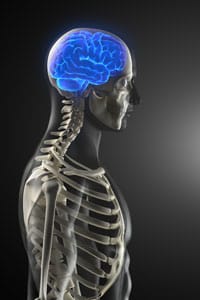Anorexia nervosa is an eating disorder characterized by an obsessive avoidance of weight gain, an accompanying purposeful restriction of daily calorie intake, and potentially severe degrees of weight loss. Some people affected by this disorder respond well to standard treatment and recover over time. However, some people develop forms of anorexia that are resistant to treatment and eventually produce life-threatening health consequences. According to the results of a pioneering study published in 2013 in the journal The Lancet, significant numbers of people with treatment-resistant anorexia get better when they receive deep brain stimulation (DBS), a surgical procedure that uses controlled electrical impulses to alter activity rates in key circuits inside the brain.
Standard Anorexia Treatment
All anorexia treatment programs are designed to do two basic things: restore the affected individual to a healthy weight and help him or her make the psychological changes necessary to avoid falling into anorexic eating patterns in the future. In many cases, the U.S. National Library of Medicine explains, treatment programs begin with a short-term hospital stay that stabilizes the patient’s health, then continue with daily outpatient services. In some cases, longer-term hospital stays are needed. Specific individuals who may require a relatively lengthy hospitalization include people whose body weight falls more than 70 percent below healthy levels, people who continue to lose weight during initial hospitalization, people who contemplate suicide or have other symptoms of advanced depression, and people who suffer from serious anorexia-related health complications. Anorexia treatment usually involves some kind of psychotherapy. Potential therapy options include family therapy, which is often used with younger patients; group therapy, which relies to a certain extent on peer interactions between anorexia patients; and cognitive behavioral therapy, a technique that teaches patients new, healthier ways to respond to stressful situations in everyday life. People affected by anorexia frequently also have other significant mental health problems, including disorders such as obsessive-compulsive disorder or major depression. Doctors may incorporate a number of different medications into anorexia treatment—including mood stabilizers, antipsychotics (neuroleptics), or antidepressants—in order to counteract or control the effects of these disorders.
Deep Brain Stimulation Basics
During a deep brain stimulation procedure, a surgeon places thin, electricity-conducting wires called electrodes into a predetermined area of the brain. He or she then attaches these wires to a pulse-generating device called a neurostimulator, which is typically implanted beneath the skin in the collarbone area. When activated, the neurostimulator sends controlled electrical signals to the electrodes in the brain. In turn, the electrical energy from these electrodes alters the function in local brain circuits by changing the rate of communication between nerve cells, called neurons, contained in those circuits. The specific region of the brain altered by deep brain stimulation varies according to the needs of the individual patient and the goals of that patient’s treatment.
Deep Brain Stimulation for Anorexia
In the study published in The Lancet, a multi-institution Canadian research team used deep brain stimulation to treat symptoms of severe, treatment-resistant anorexia in a group of six patients. These patients, who had an average age of 38, suffered from anorexia for an average of 18 years and had a total of almost 50 anorexia-related hospitalizations between them. Their illnesses had reached a stage where they were likely to die prematurely or develop debilitating lifelong health problems. In addition, five of the six patients had received a diagnosis for an additional serious form of mental illness. The circuit in the brain targeted for stimulation in these patients is known for the role it plays in emotional stability. Previous studies had shown that people with anorexia typically have significant abnormalities in this circuit (as well as in other circuits that control such things as anxiety levels and self-perception). The research team conducted follow-ups on their patients one month after deep brain stimulation surgery was performed, then conducted additional follow-ups after six months and after nine months. After making their nine-month assessments, the authors of the study found that half of the patients involved in the study had gained more weight than they had ever gained through other forms of treatment. In addition, they had managed to keep their weight up for longer than at any other point since they first developed anorexia. Also, four out of the five study participants affected by other mental illnesses experienced a significant decline in the symptoms of those illnesses. Finally, two of the six study participants went on to successfully complete standard inpatient anorexia treatment; neither of these individuals had ever finished a course of such treatment before undergoing deep brain stimulation.
Considerations
The study conducted by the Canadian research team is essentially unprecedented, and as of 2013, deep brain stimulation is viewed as an experimental anorexia treatment. Still, in the future, this technique may help control or reverse the damaging effects of severe anorexia in a large number of affected individuals.

